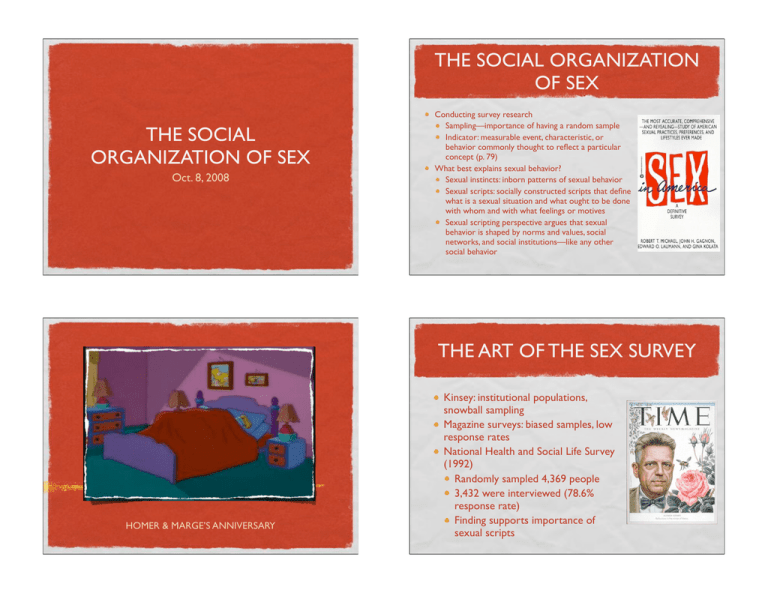
THE SOCIAL ORGANIZATION
OF SEX
THE SOCIAL
ORGANIZATION OF SEX
Oct. 8, 2008
Conducting survey research
Sampling—importance of having a random sample
Indicator: measurable event, characteristic, or
behavior commonly thought to reflect a particular
concept (p. 79)
What best explains sexual behavior?
Sexual instincts: inborn patterns of sexual behavior
Sexual scripts: socially constructed scripts that define
what is a sexual situation and what ought to be done
with whom and with what feelings or motives
Sexual scripting perspective argues that sexual
behavior is shaped by norms and values, social
networks, and social institutions—like any other
social behavior
THE ART OF THE SEX SURVEY
HOMER & MARGE’S ANNIVERSARY
Kinsey: institutional populations,
snowball sampling
Magazine surveys: biased samples, low
response rates
National Health and Social Life Survey
(1992)
Randomly sampled 4,369 people
3,432 were interviewed (78.6%
response rate)
Finding supports importance of
sexual scripts
WHO ARE OUR SEX
PARTNERS?
WHY ARE OUR SEX
PARTNERS LIKE US?
Percentage of Partnerships in Which the Two Partners
Are Similar in Social Characteristics
Type of Partnership
Type of
Similarity
Marriage
Cohabitation
Racial/ethnic
93%
88%
89%
91%
Age
78%
75%
76%
83%
Educational
82%
87%
83%
87%
Religious
72%
53%
56%
60%
Long-term
Short-term
non-cohabiting non-cohabiting
WHO INTRODUCED
PARTNERS?
Short-term non-cohabitating
NUMBER OF SEXUAL
PARTNERS
Married couples
Average number of sexual partners has increased
Over 50: a third have had five or more sexual
partners
30-50: half have had five or more sexual
partners
Rates of unfaithfulness in marriage are low
5% of married persons had > 1 partner in past
year
More time spent sexually active but unmarried
Earlier first intercourse (18 to 17-1/2 over 30
years)
Later marriage
More frequent divorce
2%
3%
37%
36%
33%
47%
9%
Mutual friends
Family
3%
13%
Coworker/classmate/neighbor
1. Useful to you
Easier to share lives
Equal social status = equal power in
relationship
Facilitates intimacy
2. Useful to your social network (stakeholders)
Parents
Friends
Professionals, moral entrepreneurs, etc.
Changing stakeholders, e.g., colleges
3. We meet people in our networks
15%
Self-introduction
Other
SEX PARTNERS IN
PAST 12 MONTHS
Men
SEX PARTNERS SINCE AGE 18
Women
Men
10% 2% 14%
5% 10%
18%
17%
Women
3%
6% 3% 3%
20%
31%
20%
16%
21%
67%
0
23%
74%
1
2-4
5+
0
Men
8%
Women
7%
14%
26%
16%
18%
30%
36%
37%
Not at all
2 or 3 times per week
10%
A few times a year
4 or more times a week
A few times per month
1
2-4
5-10
11-20
21+
FREQUENCY OF SEX
BY TYPE OF UNION
Have sex at least a few times or more per month
FREQUENCY OF SEX IN
THE PAST 12 MONTHS
36%
100%
75%
50%
25%
0%
52%
44%
Noncohabitating
Men
92% 91%
86%
Cohabitating
86%
Married
Women
Have sex at least a few times or more per month
FREQUENCY OF SEX BY AGE
100%
85%
73%
76%
73%
75%
78%
64%
66%
75%
69%
50%
49%
25%
0%
18-24
25-29
Men
30-39
40-49
Women
50-59





